Scottsdale Water has the formidable task of providing the quarter-million residents of the desert city of Scottsdale, Arizona, with water every day. Moreover, the utility must comply with the State of Arizona’s high standards of environmental sustainability and water-use efficiency. Scottsdale Water responded to these challenges with a first-of-its-kind Water Campus that returns more water to the region’s aquifer than it takes out. For its accomplishments, Scottsdale Water received the Sustainable Water Utilities Management Award from the Association of Metropolitan Water Agencies in 2018.
Brian K. Biesemeyer, PE, is the executive director of Scottsdale Water. In this interview, he speaks with Municipal Water Leader Managing Editor Joshua Dill about his utility’s unique Water Campus, its indirect potable reuse program, and its education initiatives in the Scottsdale community.
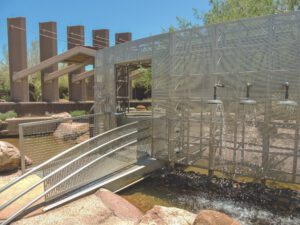 Joshua Dill: Please tell our readers about Scottsdale Water and the area it serves.
Joshua Dill: Please tell our readers about Scottsdale Water and the area it serves.
Brian Biesemeyer: Scottsdale Water is a municipal water supplier for the City of Scottsdale. We serve a fairly large geographic area—about 185 square miles—with a population of about 240,000 folks. Scottsdale is a long, narrow city, about 32 miles long and only about 8 miles wide, with a fair bit of elevation change, rising 3,700 feet from south to north. We also have some beautiful desert geography and large preserve areas in between, so our service area creates some unique challenges.
We have a little over 2,000 miles of water main with 18 pressure zones, and about 1,400 miles of sewer main with five pumpback stations. We deliver, on average, about 67 million gallons per day of potable water and up to 20 million gallons per day of reclaimed and advanced treated water for irrigation, primarily to our golf courses. Our annual operating budget is around $123 million.
Joshua Dill: Where does the water for your system come from?
Brian Biesemeyer: The largest portion of our total water supply—around 60 percent—comes from the Central Arizona Project, which is Colorado River water. We get another 13 percent from the Salt and Verde Rivers; that water is delivered to us by the Salt River Project. That Salt and Verde River water comes from watersheds in northern and eastern Arizona; they are not like the Colorado River, which runs through several states.
We also supplement our water supply during high-demand periods—at the height of our Arizona summers— with groundwater, but we are unique in that while we do pump groundwater, we actually put more water back into the ground through our recharge activities than we pump out. Scottsdale was the first city in Arizona to achieve safe yield, pumping out less groundwater than we put back in the aquifer. We have achieved safe yield every year since 2006. We are pretty proud of that, as it speaks to the sustainability of the city.
Reclaimed water makes up about 12 percent of our total water supply. In addition to our recharge efforts, we send reclaimed water to 24 different golf courses and the city’s large sports facility.
Joshua Dill: How has your district managed to achieve safe yield every year since 2006?
Brian Biesemeyer: We reached safe yield through the efforts at our Water Campus. The Scottsdale Water Campus is a facility that combines four major components of a water system. It contains the 70-million-gallon-per-day drinking water treatment facility that treats our Central Arizona Project water, a state-of-the-art water quality lab, a 20-million-gallon-per-day water reclamation facility, and our Advanced Water Treatment facility.
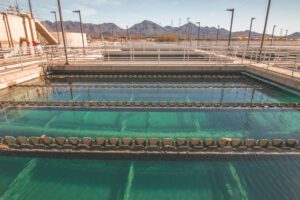
The Advanced Water Treatment facility is really what makes the Scottsdale Water Campus unique. It uses ozonation, ultrafiltration, reverse osmosis, and ultraviolet photolysis to treat water from our reclamation plant to ultrapure standards. It has a capacity of just over 20 million gallons per day. We use that ultrapure water to recharge our aquifer through indirect potable reuse.
We recharge through 63 vadose zone wells that are all within a mile of the Water Campus. We put an average of around 5 million gallons per day—every day—of ultrapure water back into the ground through our indirect potable recharge activities. We typically put more water in during the winter and pull some out in the summer. Overall, we have been putting more water in the ground than we have been taking out since 2006.
The Water Campus was the first indirect potable reuse facility in Arizona and is still one of the largest in the world. We just celebrated the 20th anniversary of indirect potable reuse at the Water Campus. The facility came online in 1998 and was really a huge achievement for the time.
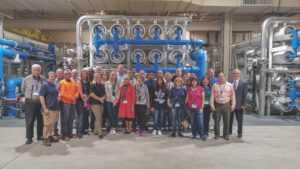 Joshua Dill: Are there any comparable facilities in the United States?
Joshua Dill: Are there any comparable facilities in the United States?
Brian Biesemeyer: I would say that the Water Campus is unique in the way that it combines all the different aspects of a complete water system in one location. And the Advanced Water Treatment facility is unique in that it has 20 years of successful operations behind it. There are other similar facilities, like Orange County Water District’s Groundwater Replenishment System, an impressive facility that recharges their aquifer, but Scottsdale’s Water Campus is about 10 years older and includes other water systems, all at one facility.
Joshua Dill: Where did the idea for your facility come from?
Brian Biesemeyer: The Water Campus idea came out of the 1980 Arizona Groundwater Management Act, which was a pioneering piece of water legislation. In the 1970s, Arizona faced the fact that we could not continue to mine groundwater endlessly. Doing so would wreak havoc on the environment and our economy. So the Arizona legislature had the foresight to pass the Groundwater Management Act, which, among other things, incentivized folks to seek out sustainable water supplies.
The Groundwater Management Act required any new development in the state’s most populous areas (designated Active Management Areas) to prove an assured water supply capable of sustaining its residents for at least 100 years. It also required that the large population areas of the state come into safe yield by the year 2025. It was because of this safe-yield requirement that Scottsdale decided, back in the early 1980s, to take hold of our water resource assets—mainly our wastewater—and come up with a way to treat that water and put it to future beneficial use.
Out of that came our Water Campus. We knew that we needed to recharge groundwater. We also knew that Scottsdale sits on a very pristine drinking water aquifer, which we were committed to not affecting. So we made the decision decades ago that the water we put back in the aquifer would be of a quality equal to or better than the water that was naturally down there, which meant we needed to expand not only our surface water treatment capacities but also our wastewater treatment capabilities. We also knew that we would need a state-of-the-art lab to ensure that everything worked.
The ideas and planning for the campus began in the late 1980s and early 1990s, construction started in the mid- 1990s, and we started processing water in October 1998.
Joshua Dill: What are the advantages of groundwater recharge? Is the process better than simply reusing the purified water immediately?
Brian Biesemeyer: In our case, I would argue that groundwater recharge is better. The large aquifer underneath Scottsdale gives us long-term supply flexibility and also lets us put a lot of water in the ground in the winter when it is not being consumed and then pull some of it out in the summer when our demands are much higher. It gives us the tremendous advantage of having a large storage tank right underneath us.
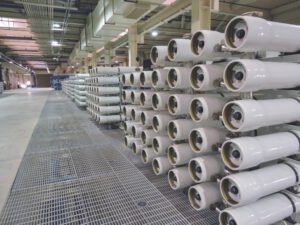 That said, while recharge is the best option for Scottsdale, immediate reuse is close to becoming a viable option in Arizona. The state recently removed the prohibition against direct potable reuse, and since Scottsdale has the operational experience and the technology in place, we are working with the Department of Environmental Quality to define the regulatory requirements and the permitting process to enable cities here in Arizona to begin direct potable reuse.
That said, while recharge is the best option for Scottsdale, immediate reuse is close to becoming a viable option in Arizona. The state recently removed the prohibition against direct potable reuse, and since Scottsdale has the operational experience and the technology in place, we are working with the Department of Environmental Quality to define the regulatory requirements and the permitting process to enable cities here in Arizona to begin direct potable reuse.
Joshua Dill: Is Scottsdale being affected by the Colorado River drought?
Brian Biesemeyer: Yes, drought is an issue, but Arizona as a state has been pushing the conservation message through its water utility programs for over three decades. The 1980 Groundwater Management Act made water conservation a requirement for water providers. Water conservation is just a way of doing business in Arizona; it has been a constant theme running through all our utilities for decades. We have always recognized that we live in a desert state and that our state is subject to drought. So while we continually tighten our conservation efforts and strive to become more innovative, we have not had to make any drastic changes in our waterconservation effort in response to the drought.
Storing our water underground also allows us some cushion for drought. We don’t necessarily want to use those reserves, but if we have to, we could withdraw the water from the groundwater table as a drought-mitigation measure.
Joshua Dill: Does the district have any citizen-education programs regarding water use efficiency?
Brian Biesemeyer: We have a wide variety of programs. On the conservation side, we have a variety of programs including both classroom-based youth-education programs and free adult workshop programs that focus on a bunch of water efficiency topics. We offer rebates for installation of a large assortment of WaterSense fixtures, as well as some unique rebates for the removal of high-water-use fixtures. We’ll pay folks to convert their turf to desert-adapted landscaping, and Scottsdale was the first, and I believe is still the only, city in Arizona to offer rebates for spa and swimming pool removal and water softener removal. Water softeners are a particularly big issue for us because not only do they add to water demand, but they also return huge amounts of salt back into our wastewater-collection system, which we have to remove before we can reuse that water.
In Scottsdale, we’ve taken education outreach a step further and cover things beyond just water-use efficiency. In 2015, we launched the Scottsdale Water Citizen Academy with the goal of educating our residents and stakeholders about everything we do here at Scottsdale Water. The Academy is a course, with a class one night a week for 5 weeks, that covers all aspects of a sustainable water utility: treatment, distribution, collection, reclamation, water quality, finance, engineering—you name it, we cover it. The program is incredibly popular, so much so that we had to add a second session: We do it twice a year now. Most people take their water for granted, but when you tell them all that we do every day, they really love it. It was named the 2017 Public Education Program of the Year by the WateReuse Foundation. It’s a lot of work, but we’re really proud of it.
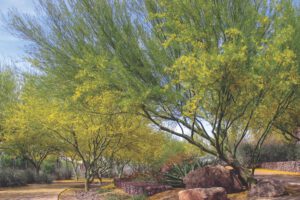 Joshua Dill: Tell us about the award you recently received from the Association of Metropolitan Water Agencies.
Joshua Dill: Tell us about the award you recently received from the Association of Metropolitan Water Agencies.
Brian Biesemeyer: Scottsdale Water has a history of being recognized for our vision and overall water sustainability. We just received the Sustainable Water Utilities Management Award from the Association of Metropolitan Water Agencies in our first year of eligibility—we received the Platinum Award in 2015—which was a huge honor, and really shows our commitment to our vision. We were also named a Utility of the Future Today in 2016 by a consortium of water agencies led by the U.S Enviornmental Protection Agency. That was great because it recognized us specifically for organizational culture, community partnering and engagement, energy efficiency, and water reuse, things that I think we do really well. I do think these awards are important because they reflect Scottsdale Water’s commitment to sustainability and acknowledge the great work our people do every day.
Joshua Dill: What are some lessons that your water district can share with other districts across the country?
Brian Biesemeyer: Our vision is water sustainability through stewardship, innovation, and people. We have been successful in creating a sustainable water system for the city through those three things. And while it will cost money up front, we have found that if you invest in those things strategically and put a lot of effort into doing so efficiently, the costs are not much higher than traditional systems and provide a long-term payback for the whole community. That commitment to sustainability also assures the community that they will have a long-term water supply that they can use now and long into the future.
Joshua Dill: What is your vision for the future?
Brian Biesemeyer: Scottsdale Water’s vision for the future is to continue to support innovation and people. The people who work for us do amazing things every day and are truly dedicated to our customers. We are going to continue to invest in them. We are also going to keep pursuing innovation so that we can find new and different ways to maintain a sustainable water supply. My job is to cultivate the skills of our people and to invest in the tools they need to allow them to do their jobs well every single day.
Brian K. Biesemeyer, PE, is the executive director of Scottsdale Water. He can be reached at bbiesemeyer@ScottsdaleAZ.gov.
